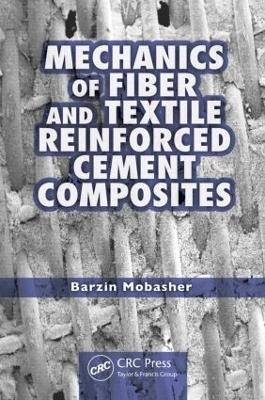
Mechanics of Fiber and Textile Reinforced Cement Composites
Crc Press Inc (Verlag)
978-1-4398-0660-9 (ISBN)
- Titel z.Zt. nicht lieferbar
- Versandkostenfrei innerhalb Deutschlands
- Auch auf Rechnung
- Verfügbarkeit in der Filiale vor Ort prüfen
- Artikel merken
Among all building materials, concrete is the most commonly used—and there is a staggering demand for it. However, as we strive to build taller structures with improved seismic resistance or durable pavement with an indefinite service life, we require materials with better performance than the conventional materials used today. Considering the enormous investment in public infrastructure and society’s need to sustain it, the need for new and innovative materials for the repair and rehabilitation of civil infrastructure becomes more evident. These improved properties may be defined in terms of carbon footprint, life-cycle cost, durability, corrosion resistance, strength, ductility, and stiffness.
Addressing recent trends and future directions, Mechanics of Fiber and Textile Reinforced Cement Composites presents new opportunities for developing innovative and cost-effective materials and techniques in cement and concrete composites manufacturing, testing, and design. The book offers mathematical models, experimental results, and computational algorithms for efficient designs with fiber and textile reinforced composite systems. It explores alternative solutions using blended cements, innovative reinforcing systems, natural fibers, experimental characterization of key parameters used for design, and optimized designs. Each chapter begins with a detailed introduction, supplies a thorough overview of the existing literature, and sets forth the reasoning behind the experimentation and theory.
Documenting the composite action of fibers and textiles, the book develops and explains methods for manufacturing and testing cement composites. Methods to design and analyze structures for reduced weight, increased durability, and minimization of cement use are also examined. The book demonstrates that using a higher volume fraction of fiber systems can result in composites that are quasi-elastic plastic. Speaking to the need to
Barzin Mobasher obtained his BS and MS in civil engineering from the University of Wisconsin-Platteville and Northeastern University in 1983 and 1985, respectively. He received his PhD in civil engineering from Northwestern University in 1990 and was a member of the Technical Staff at USG Corporation during 1990–1991. He joined the Department of Civil and Environmental Engineering at Arizona State University in 1991 as an assistant professor of structural materials. He has been a professor of engineering at ASU since 2004. Dr. Mobasher has led programs involved with the design, analysis, materials testing, and full-scale structural testing of construction and structural materials. His list of publications includes more than 150 research papers in leading professional journals and conference proceedings. He has made fundamental contributions to the field of fiber and textile reinforced concrete materials and mechanics of toughening in cement-based systems, modeling the mechanical and durability of materials, and experimental mechanics. He has served as the Chair of the American Concrete Institute, ACI Committee 544 on Fiber Reinforced Concrete, and has been a reviewer for a variety of journals. For more information about Dr. Mobasher, see Dr.Mobasher’s web site at ASU.
Cement-Based Composites—A Case for Sustainable Construction. Historical Aspects of Conventional Fiber-Reinforced Concrete Systems. Ductile Cement Composite Systems. Textile Reinforcement in Composite Materials. Single Yarns in Woven Textiles: Characterization of Geometry and Length Effects. Introduction to Mechanics of Composite Materials. Mechanical Testing and Characteristic Responses. Fiber Pullout and Interfacial Characterization. Fracture Process in Quasi-Brittle Materials. Tensile Response of Continuous and Cross-Ply Composites. Inelastic Analysis of Cement Composites Using Laminate Theory. Tensile and Flexural Properties of Hybrid Cement Composites. Correlation of Distributed Damage with Stiffness Degradation Mechanisms. Flexural Model for Strain-Softening and Strain-Hardening Composites. Back-Calculation Procedures of Material Properties from Flexural Tests. Modeling of Fiber Reinforced Materials Using Finite Element Method. Flexural Design of Strain-Softening Fiber Reinforced Concrete. Fiber Reinforced Aerated Concrete. Sisal Fiber Reinforced Composites. Restrained Shrinkage Cracking. Flexural Impact Test. Textile Composites for Repair and Retrofit. Retrofit of Reinforced Concrete Beam–Column Joints Using Textile Cement Composites. Dynamic Tensile Characteristics of Textile Cement Composites. Index.
| Erscheint lt. Verlag | 26.10.2011 |
|---|---|
| Verlagsort | Bosa Roca |
| Sprache | englisch |
| Maße | 178 x 254 mm |
| Gewicht | 1040 g |
| Themenwelt | Technik ► Maschinenbau |
| ISBN-10 | 1-4398-0660-8 / 1439806608 |
| ISBN-13 | 978-1-4398-0660-9 / 9781439806609 |
| Zustand | Neuware |
| Haben Sie eine Frage zum Produkt? |
aus dem Bereich


